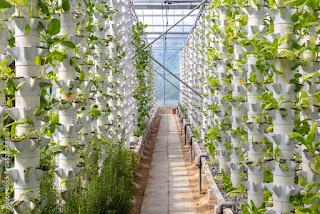Introduction:
As the global population continues to grow and urbanization expands, traditional agricultural methods face significant challenges in meeting the demand for fresh and sustainable food. In this context, vertical farming has emerged as a revolutionary solution to address these issues. By utilizing vertical space and advanced cultivation techniques, vertical farming offers numerous benefits that go beyond traditional agriculture. In this blog, we will explore the advantages of vertical farming and how it maximizes space and yield to meet the world's food requirements.
1. Efficient Space Utilization:
One of the key advantages of vertical farming is its ability to maximize land usage. Traditional agriculture relies on large plots of land, which are limited and often located far from urban centers. Vertical farming, on the other hand, utilizes vertical space by stacking layers of crops vertically, making it possible to grow large quantities of food in a relatively small footprint. By going upward instead of outward, vertical farming allows cultivation in urban areas, unused buildings, and even in areas with limited access to arable land.
2. Increased Crop Yield:
Vertical farming utilizes advanced technologies such as hydroponics, aeroponics, and aquaponics, which provide optimal growing conditions for crops. These techniques involve growing plants in nutrient-rich water solutions or with minimal soil, using controlled environments that provide ideal temperature, light, and humidity levels. Such precision cultivation methods result in accelerated plant growth, higher yields, and multiple harvests throughout the year. Compared to traditional farming, vertical farming can produce significantly more crops per square meter, ensuring a consistent and abundant food supply.
3. Water and Resource Conservation:
Traditional agriculture consumes vast amounts of water and relies heavily on chemical fertilizers and pesticides. In contrast, vertical farming implements efficient irrigation systems that recycle water, reducing water consumption by up to 90% compared to traditional farming methods. The closed-loop systems in vertical farms retain and filter water, allowing for precise nutrient delivery to plants while minimizing waste. Additionally, vertical farming minimizes the need for harmful chemicals, making it an environmentally friendly alternative that promotes sustainable farming practices.
4. Year-Round Crop Production:
Vertical farms create ideal growing conditions regardless of external factors such as seasons or weather conditions. By controlling factors like temperature, humidity, and lighting, vertical farming enables year-round crop production. This consistent and reliable supply of fresh produce eliminates seasonal limitations, reduces dependence on long-distance transportation, and ensures that consumers have access to locally grown, nutrient-rich food throughout the year. This aspect of vertical farming contributes to food security, reduces the carbon footprint associated with transportation, and supports a more sustainable food system.
5. Urban Food Production and Food Security:
As cities expand, the distance between rural farming areas and urban centers grows, leading to longer transportation times and increased energy consumption. Vertical farming offers a solution by bringing agriculture closer to urban areas, creating opportunities for local food production. By establishing vertical farms within or near cities, fresh produce can be harvested and delivered to consumers quickly, reducing the time and resources needed for transportation. This localized food production enhances food security, improves access to nutritious food, and strengthens local economies.
Conclusion:
Vertical farming is a game-changer in the world of agriculture, addressing the challenges of limited land, increasing population, and the need for sustainable food production. With its efficient use of space, higher crop yields, resource conservation, year-round production, and urban food production capabilities, vertical farming offers a promising solution to feed a growing global population while minimizing environmental impact. As we embrace innovative farming practices, vertical farming has the potential to revolutionize the way we grow and consume food, paving the way for a more sustainable and resilient future.


